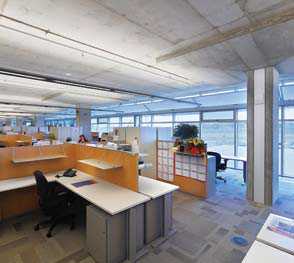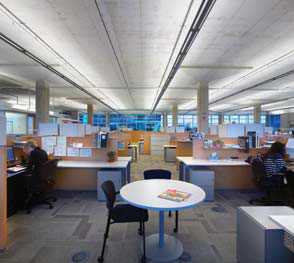Lighting Styles

There are many lighting styles, each with different considerations for people impacted by blindness.
Spotlighting casts a strong light on a small area. In normal circulation routes or work areas, it’s not usually recommended because it can create strong contrasts that cause eye adaptation problems for people with certain kinds of blindness. Spotlighting is best used to supplement general illumination by highlighting specific features or as task lighting for a specific work location.
For example, many hotel reception desks and bank counters use overhead spotlights directly above the counter area to aid with reading and writing. This benefits many people impacted by blindness who still have some usable vision. Note that these lights need to be positioned so that users don’t create shadows on their own work surfaces.

An office area with a general lighting level of about 500 lux would benefit from task lighting from adjustable desk lamps providing illumination levels from 1,000 to 1,500 lux. However, the same desk lamps used in an area with a lower general illumination level of 50 lux will create eye adaptation problems, because the light contrast between the general light level and the workstation is too great.
Where task lighting is provided close to the user, fluorescent lighting in the form of CFLs is a safe option that doesn’t generate the heat of incandescent or halogen illumination.
Uplighting and indirect lighting reflect light onto a ceiling or wall, which then indirectly illuminates a space. This is often effective in providing lighting without strong shadows or glare.
Uplighting or indirect lighting can be accomplished with different lighting designs or lamp types. The three most common types are suspended indirect fixtures, freestanding uplights and wall sconces.
Suspended indirect fixtures can provide even, diffused lighting in many applications and in spaces of varying size. These fixtures are hung 450 – 610 mm below the finished ceiling and are designed with reflectors that provide an almost 180-degree spread of light that washes the ceiling evenly. Combining indirect lighting with task lighting allows flexibility to respond to specific light needs for users who need brighter, more localized lighting.
Reflecting light off a ceiling mitigates glare on items such as computer screens and signage, especially when compared to traditional ceiling-mounted lighting.
Freestanding uplights are recommended in small spaces because they can be moved to suit the activity. To counteract the reduced brightness that results when light reflects off a ceiling, increase the wattage of the bulbs or use more powerful fixtures.
Wall sconces with an upward component reflect light off a ceiling as well as the wall on which they are mounted. By positioning them at regular intervals, they can be used to create a visual rhythm that can help people find their way through spaces such as public corridors. They can also be positioned to focus on specific features, such as doorways.